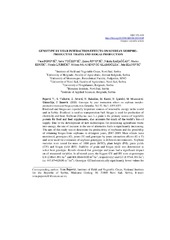Приказ основних података о документу
Genotype by year interaction effects on soybean morpho-productive traits and biogas production
| dc.creator | Popović, Vera | |
| dc.creator | Vučković, Savo | |
| dc.creator | Jovović, Zoran | |
| dc.creator | Rakaščan, Nikola | |
| dc.creator | Kostić, Marko | |
| dc.creator | Ljubičić, Nataša | |
| dc.creator | Mladenović-Glamočlija, Milena | |
| dc.creator | Ikanović, Jela | |
| dc.date.accessioned | 2021-04-26T19:55:36Z | |
| dc.date.available | 2021-04-26T19:55:36Z | |
| dc.date.issued | 2020 | |
| dc.identifier.issn | 0534-0012 | |
| dc.identifier.uri | http://fiver.ifvcns.rs/handle/123456789/2041 | |
| dc.description.abstract | Biodiesel and biogas are especially important sources of renewable energy in the world and in Serbia. Biodiesel is used as transportation fuel; biogas is used for production of electricity and heat. Soybean (Glycine max L.) grain is the primary source of vegetable protein for food and feed supplements, also accounts for much of the world's bio-oil supply. Due to the development of new technologies for processing agricultural waste into energy, the rate of increase in the use of alternative fuels is significantly increasing. The aim of this study was to determine the productivity of soybeans and the possibility of obtaining biogas from soybeans in divergent years, 2017-2019. Main effects were monitored, genotypes (G), years (Y) and genotype by years interaction effects (G x Y) and were used for evaluation of soybean genotypes in different environments. Soybean varieties were tested for mass of 1000 grain (MTG), plant height (PH), grain yields (GY) and biogas yield (BY). Stability of grain and biogas yield was determined to select best genotype. Results showed that genotype and years had a significant impact on all measured variables. In all tested years, the biggest GY and BY were at genotypes G1 (2.40-4.49 t ha(-1), and 461.00-641.00 m(3) ha(-1), respectively) and G3 (1.97-4.30 t ha(-1); i.e. 447.67-620.00 m(3) ha(-1)). Genotype G2 had statistically significantly lower values for all tested parameters compared to other tested genotypes. Correlation analysis of some chosen traits showed different interdependence between measured variables depending on the year conditions. The results of this study pointed out that among best genotypes for production of grain and biogas were G1 and G3. From the results of this study it can be concluded that G x Y trials are important for evaluation of stability and choosing the most stable genotypes of soybean. | en |
| dc.publisher | Društvo genetičara Srbije, Beograd | |
| dc.relation | info:eu-repo/grantAgreement/MESTD/inst-2020/200032/RS// | |
| dc.relation | Bilateralni projekat Crna Gora-Srbija: Alternativna žita i uljarice kao izvor zdravstveno bezbedne hrane i važna sirovina za proizvodnju biodizela (2019-2020) | |
| dc.relation | info:eu-repo/grantAgreement/MESTD/inst-2020/200118/RS// | |
| dc.relation | info:eu-repo/grantAgreement/MESTD/inst-2020/200358/RS// | |
| dc.rights | openAccess | |
| dc.rights.uri | https://creativecommons.org/licenses/by-nc-nd/4.0/ | |
| dc.source | Genetika-Belgrade | |
| dc.subject | soybean | en |
| dc.subject | genotype | en |
| dc.subject | grain yield | en |
| dc.subject | biogas yield | en |
| dc.subject | correlation | en |
| dc.title | Genotype by year interaction effects on soybean morpho-productive traits and biogas production | en |
| dc.type | article | |
| dc.rights.license | BY-NC-ND | |
| dc.citation.epage | 1073 | |
| dc.citation.issue | 3 | |
| dc.citation.other | 52(3): 1055-1073 | |
| dc.citation.rank | M23 | |
| dc.citation.spage | 1055 | |
| dc.citation.volume | 52 | |
| dc.identifier.doi | 10.2298/GENSR2003055P | |
| dc.identifier.fulltext | http://fiver.ifvcns.rs/bitstream/id/970/2038.pdf | |
| dc.identifier.scopus | 2-s2.0-85098114512 | |
| dc.identifier.wos | 000599450700017 | |
| dc.type.version | publishedVersion |


